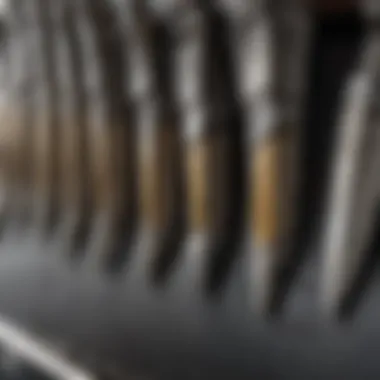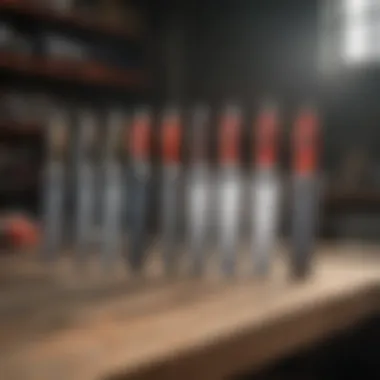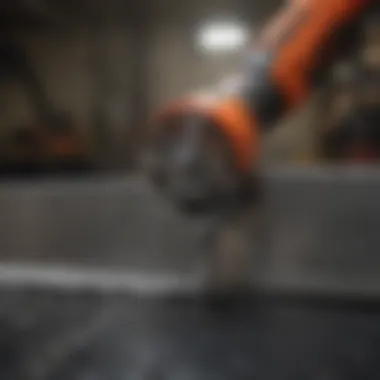Top Sawzall Blades for Cutting Metal Reviewed


Overview of Topic
When it comes to the home improvement industry, the right tools can make a significant difference in the outcome of any project. Among these tools, sawzall blades hold special importance, especially for cutting metal. A sawzall, or reciprocating saw, is designed for versatility and can handle a variety of materials. However, the effectiveness of this tool largely depends on the blade used.
The significance of selecting the best sawzall blades for metal cannot be overstated. Unlike wood or plastic, cutting metal requires specialized blades crafted from durable materials. These blades must withstand higher levels of stress and heat. Quality blades can lead to cleaner cuts, safer operation, and increased efficiency in metalworking projects.
Common Challenges and Solutions
Homeowners often face several challenges when cutting metal. Some of the most common issues include:
- Blade Wear: Metal can quickly dull an inferior blade, leading to poor performance.
- Heat Buildup: Prolonged cutting can cause excess heat, which may warp the blade.
- Inaccurate Cuts: Lack of proper control can result in jagged or uneven cuts.
Solutions
To mitigate these challenges, consider the following tips:
- Choose high-quality blades made of bi-metal or carbide materials to enhance durability.
- Use a blade with a proper tooth count for the type of metal being cut.
- Maintain a steady pace when cutting to prevent overheating and ensure accuracy.
"Investing in the right sawzall blade is crucial for achieving professional results in metal cutting."
Product Recommendations
When evaluating the best sawzall blades for metal, several industry-leading products stand out. Popular choices include:
- Milwaukee 48-00-1450: Known for its bi-metal construction, it effectively cuts through various metals.
- DeWalt DW4892: This is a 9-inch blade designed specifically for metal cutting, with a solid tooth design for enhanced durability.
- Starrett 59951: A premium option, this blade features alloy steel for superior performance and longevity.
These products offer essential features such as increased tooth hardness, which significantly enhances cutting speed and lowers vibration.
Step-by-Step Guides
To ensure optimal results when using sawzall blades, follow these practical steps:
- Select the Appropriate Blade: Ensure that the blade is suitable for the type of metal you plan to cut. Consider factors like thickness and material.
- Secure the Metal: Use clamps or vices to hold the metal securely in place. This will minimize movement and improve cutting accuracy.
- Set the Saw to the Right Speed: Adjust the speed settings of your sawzall according to the material type.
- Start Cutting: Begin the cut with a light pressure. Gradually increase as needed, ensuring the blade does not overheat.
- Inspect the Cut: After finishing, check the cut’s quality and make any necessary adjustments for a cleaner finish.
Understanding Sawzall Blades
Understanding Sawzall blades is crucial for anyone involved in metal cutting tasks. A proper comprehension of these tools can lead to significant improvements in efficiency and safety. With the right blade, tasks that could take hours can be accomplished in minutes. Not only does this save time, but it also reduces the physical strain that can come from using incorrect tools. This section will guide readers through the main aspects of Sawzall blades, ensuring they make informed decisions when choosing the right one for their needs.
Definition and Purpose of Sawzall Blades
Sawzall blades are designed for use with reciprocating saws, commonly known as Sawzalls. They are specialized blades that vary in tooth design, material, and length to accommodate different cutting requirements. The primary purpose of these blades is to cut through a variety of materials, including wood, plastic, and most importantly, metal. The adaptability of Sawzall blades allows users to modify their approach depending on the task at hand.
Typically, these blades are employed in construction, demolition, and even maintenance activities, demonstrating their versatility across various fields. It is essential to select the appropriate blade for the material and task. With the right choice, one can achieve more precise cuts and improve overall project outcomes.
Key Differences: General Purpose vs. Metal Cutting Blades
When it comes to Sawzall blades, understanding the differences between general-purpose and metal cutting blades is vital. General-purpose blades are versatile and can be used for various materials, but their effectiveness may be limited when cutting metals. These blades typically have a less aggressive tooth design which may lead to slower cuts or less clean edges.
In contrast, metal cutting blades are specifically engineered to address the unique challenges of cutting through harder materials like steel or aluminum. Key features of metal cutting blades include:
- Tooth Composition: Generally, metal cutting blades are made from bi-metal or high-speed steel, offering superior durability and heat resistance.
- Tooth Count: These blades usually have a higher tooth count, allowing for smoother cuts and reducing the risk of chipping or damage to the material.
- Blade Width and Thickness: Metal cutting blades are often thicker and more rigid, providing the stability required for accurate cuts in tough materials.
Understanding these differences can significantly enhance cutting efficiency and reduce wear on your tools.
By recognizing the distinctions between general-purpose and metal cutting Sawzall blades, users can make better decisions regarding which blade to employ for specific tasks.
Types of Sawzall Blades for Metal
In this section, we will delve into the various types of sawzall blades specifically designed for cutting metal. Understanding these categories is crucial for selecting the right blade for your project. Each type of blade serves a distinct function depending on the material characteristics, the thickness of the metal, and the nature of the cutting task. Selecting the correct type ensures effectiveness, enhances safety, and prolongs the life of the blade.


Bi-Metal Blades
Bi-metal blades are a popular choice for metal cutting tasks. They combine two different types of metal to create a blade that is both flexible and durable. The core is typically made of high-speed steel, while the teeth are crafted from very hard high-speed steel. This combination provides strength and the ability to withstand the heat generated by high-speed cutting.
Key Benefits:
- Durability: They resist wear and maintain sharpness longer than standard steel blades.
- Flexibility: These blades can absorb shocks without breaking, allowing for a smooth cutting process.
- Versatile Application: Suitable for a wide range of metals, including stainless steel and aluminum.
Bi-metal blades are especially useful when high performance is needed. They allow you to cut through thicker metals effectively, making them an excellent investment for both casual homeowners and professional tradespeople.
Carbide Grit Blades
Carbide grit blades are engineered for cutting through hard materials. They feature a base metal with a coating of carbide particles bonded to the surface. This construction allows them to tackle tough substances, like tile or metal with a hard surface.
Considerations for Use:
- Grinding Effect: The carbide grits grind through the material. This makes them ideal for harder, thicker metals.
- Cutting Speed: They generally operate at slower speeds compared to bi-metal blades, but their efficiency is remarkable for tough cuts.
- Specific Applications: Best suited for specialized tasks such as demolition or working with materials that have diverse densities.
Homeowners may find carbide grit blades beneficial when engaging in renovation projects or preparations that involve cutting through resilient materials. However, given their purpose, they may not be ideal for everyday metal cutting tasks.
High-Speed Steel Blades
High-speed steel blades are primarily made from a steel alloy that is manufactured for hardness and cutting efficiency. Thesef blades are often cost-effective and can be used for a range of metal cutting tasks.
Advantages:
- Affordability: Generally cheaper than specialized blades, making them accessible for household projects.
- Efficiency: They perform well in various cutting processes, suitable for both soft and heavy metals.
- Light-Duty Applications: These blades are best for thinner materials and lighter tasks.
Choosing high-speed steel blades may be ideal for house owners who engage in periodic home improvement tasks or DIY projects. They provide a practical entry point into metal cutting without the need for a significant investment.
Factors Influencing Blade Selection
When it comes to choosing the right Sawzall blade for metal cutting, several factors come into play that can significantly influence your selection. This section outlines the most important elements that should guide your decision-making process, ensuring you achieve the best cutting results. Understanding these components allows users to select blades that fit specific tasks effectively, enhancing both efficiency and safety during operation.
Material Thickness
The thickness of the material you intend to cut directly affects the type of Sawzall blade to choose. Thicker materials require blades that are designed to handle greater resistance and strain. For example, when cutting mild steel or heavy-duty metals, a robust blade with a substantial tooth structure may be necessary. On the other hand, thinner sheets may only need a lighter blade with finely spaced teeth.
- Blade Recommendations by Thickness:
- For materials up to 1/8 inch: Use high tooth-count blades for smoother cuts.
- For materials between 1/8 inch and 1/2 inch: Bi-metal blades are useful, combining flexibility with strength.
- For materials over 1/2 inch: Look for heavy-duty blades crafted specifically for tough cuts.
This distinction is crucial because selecting the wrong blade could lead to suboptimal cuts, premature wear, or even damaging the material being cut.
Type of Metal
Different metals possess various characteristics affecting the cutting blade's efficiency. Considerations like hardness, tensile strength, and alloy composition play significant roles in selecting the appropriate Sawzall blade. For instance, high-carbon steel, stainless steel, and aluminum each require blades optimized for their unique properties.
- Blade Tips for Various Metals:
- Stainless Steel: A bi-metal blade designed with a high tooth count works best due to the metal's toughness.
- Aluminum: A finer tooth blade provides clean cuts without burrs or jagged edges.
- Mild Steel: Commonly, standard bi-metal blades are effective enough for most tasks.
Choosing the right blade based on the type of metal ensures a smoother cutting experience and enhances blade longevity. Misselecting blades can lead to overheating or damage.
Compatibility with Sawzall Models
Another important factor in selection is ensuring that the blade is compatible with the specific Sawzall model being used. Not all blades fit all models, and this could affect functionality and safety. Some saws use a universal shank, while others might require specific fittings.
- Here are key points to check for compatibility:


- Shank Type: Ensure the shank type of the blade matches the Sawzall model.
- Length of Blade: Fitment varies across models; confirm the blade length works with your specific tool.
- Manufacturer Recommendations: Always consult the manufacturer’s guidelines for compatibility.
Despite some blades appearing visually similar, their design can drastically affect performance when paired with the wrong model. Therefore, verifying compatibility is paramount for effective cutting operations.
Performance Characteristics of Metal Cutting Blades
When selecting a Sawzall blade for cutting metal, understanding its performance characteristics is crucial. These traits determine how effectively a blade will work, influencing not just cutting speed, but also the overall quality of the cut and the lifespan of the blade. Key performance factors include tooth count and configuration, cutting speed and efficiency, and the thickness and rigidity of the blade. Each of these characteristics should be carefully evaluated based on the specific tasks at hand, ensuring that you achieve the desired results.
Tooth Count and Configuration
The tooth count and design on a Sawzall blade significantly affect how it performs when cutting metal. A higher tooth count usually leads to a finer finish. Conversely, a lower tooth count allows for faster cuts but with a rougher edge. Therefore, knowing the material and the desired finish is essential.
- Tooth Count: Generally, for thinner metals, a blade with more teeth is preferable. This is because it permits smoother cuts and less friction. Heavier metal might require fewer teeth for quicker penetration.
- Tooth Configuration: The angle and shape of the teeth also matter. For example, a blade with wavy teeth can be more suitable for cutting tougher materials, as it allows for better chip removal and less binding.
Choosing the right tooth count and configuration can be the difference between a clean cut and an unfinished edge.
Cutting Speed and Efficiency
Cutting speed is defined by how quickly a blade can slice through metal. Efficiency directly correlates with the blade's design and material.
- Material Composition: Blades made from bi-metal or carbide tend to have higher cutting speeds and can handle metal cutting tasks well. The composition often indicates how heat-resistant the blade is.
- RPM Compatibility: The effectiveness of a blade also relies on the tool's RPM. Ensuring your Sawzall can reach the recommended RPM range will enhance cutting speed.
- Applications: Consider the application as well. Thicker metals will inherently slow the cutting process, necessitating a balance between speed and cutting precision.
"A slower speed can reduce heat buildup, prolonging blade life and producing cleaner edges."
Blade Thickness and Rigidity
Blade thickness and rigidity hold immense significance in cutting performance. A blade's thickness often determines its strength during heavy-duty cuts.
- Thickness: Thicker blades usually withstand more force; hence they are suitable for cutting through tougher materials. However, they can be harder to control for fine work.
- Rigidity: The rigidity of a blade plays a pivotal role in preventing bending or breaking during cuts. A rigid blade will provide straighter cuts and enhance accuracy.
In summary, assessing these performance characteristics enables housewives and homeowners to select the best Sawzall blades for their specific metal cutting needs, ensuring both efficiency and safety during use.
Top Sawzall Blades for Metal: Comparative Analysis
Choosing the right Sawzall blades for metal cutting is crucial for achieving effective and efficient results. This section focuses on a comparison of several top brands, highlighting the important features and benefits that can influence purchasing decisions. By examining the distinctions among various models, readers can identify which blade best suits their specific needs and projects.
When working with metal, blade performance greatly impacts cutting speed, durability, and overall efficiency. Thus, understanding the differences in design, material, and intended use is essential. The following analysis will provide insights into the strengths of the leading brands in the market, ensuring you make an informed choice.
Brand A: Features and Benefits
Brand A is well-known for its extensive offering of high-quality Sawzall blades designed for metal cutting.
- Durability: The blades are constructed using a bi-metal design, enhancing their lifespan.
- Cutting Performance: With a tooth design optimized for metal, these blades offer smooth and rapid cutting.
- Versatility: They work effectively across various thicknesses, making them suitable for professional and DIY projects.
Overall, Brand A prioritizes endurance and cutting efficiency, making it a reliable choice for homeowners.
Brand B: Features and Benefits
Brand B is praised for its innovative approach to blade design, particularly in the context of heavy-duty cutting tasks.
- Advanced Coating: Their blades often feature a special coating that reduces friction and heat, thereby preventing wear during prolonged use.
- Tooth Geometry: Unique configurations allow for faster cutting of different types of metal, including stainless steel.
- Compatibility: The blades are compatible with a wide range of Sawzall models, providing flexibility for users.
Brand B wins commendations in settings requiring heavy use and demanding materials.
Brand C: Features and Benefits
Brand C specializes in blades that cater specifically to intricate or detailed metalwork.
- Fine Tooth Count: This increases the precision of cuts, ideal for sheet metalwork and close tolerances.
- Lightweight: The blades are designed to be lighter, which reduces user fatigue during extensive projects.
- Affordability: Compared to other top brands, Brand C often offers competitive pricing, making it attractive for budget-conscious homeowners.


The precision and cost-effectiveness of Brand C make it a popular choice for those working on detailed metal projects.
Brand D: Features and Benefits
Brand D is recognized for its rugged design suitable for industrial applications, notably in construction or demolition work.
- High-Rigidity Steel: Utilizes thicker materials, increasing strength and stability during use.
- Specialized for Thick Metal: These blades are explicitly designed for cutting through heavy metal, such as steel beams or thicker pipes.
- Long Life Span: Their durable construction means they can withstand harsh conditions and prolonged wear.
For those involved in heavy-duty metal cutting, Brand D emerges as a prominent competitor.
This comparative analysis reveals that each brand presents unique advantages tailored to various cutting needs. By evaluating features and benefits, users can choose the ideal Sawzall blade for their projects.
Recommendations for Specific Applications
Understanding the specific applications for which different Sawzall blades are used is crucial for optimizing cutting performance. Choosing the right blade not only ensures efficiency but also extends the life of both the blade and the tool. Each type of job, whether it be cutting sheet metal, pipes, or framing steel, presents unique challenges and demands particular features in blades. This section elaborates on tailored recommendations for several applications, assisting users in selecting the most suitable blade for their needs.
Cutting Sheet Metal
When it comes to cutting sheet metal, precision is a priority. Using the correct Sawzall blade minimizes the risk of warping and promotes clean cuts. Bi-metal blades are often recommended for their flexibility and durability. They are effective at cutting through thinner gauges without sacrificing performance. A blade with a higher tooth count, around 14 to 18 teeth per inch, can greatly enhance the quality of the cut.
Consider the thickness of the sheet metal being cut. For example, metals up to 18 gauge benefit from blades designed specifically for sheet metal, while thicker materials might require different types. Users should always aim for a smooth and steady motion while operating the tool, which helps in achieving a cleaner cut.
"Selecting a blade with the appropriate tooth count is key for achieving precision in metal work."
Cutting Pipes and Tubing
Cutting pipes and tubing presents its unique requirements. The blade chosen must accommodate the type of material involved, whether it be copper, PVC, or stainless steel. Carbide grit blades are particularly effective in this context due to their ability to handle tough materials. For thicker pipes and tubing, a lower tooth count, around 8 to 10 teeth per inch, is generally more effective. This promotes a more aggressive cut needed to penetrate harder surfaces.
Be mindful of the pipe’s diameter as well. Larger diameter pipes will benefit from versatility in motion and a blade that can maintain steady pressure. When dealing with soft metals, bi-metal blades also perform well and guarantee durability against wear and tear.
Dealing with Framing Steel
Working with framing steel demands strength and stability. High-speed steel blades are often the preferred choice for cutting through the hard materials found in construction. These blades can withstand the stress and pressure common in framing tasks.
Users should select a blade designed for heavy-duty applications, typically equipped with a thicker gauge and a tooth configuration that can handle the rigors of framing. Using blades in the 14 to 18 teeth per inch range may yield satisfactory results, as they provide the balance needed between cutting speed and finish quality.
Finally, applying proper technique is essential. Employing a slow and steady approach minimizes heat buildup, which can cause blade failure. Ensuring the blade is adequately lubricated can further enhance its performance and longevity.
Selecting blades tailored for these specific applications enables homeowners and other users to optimize their cutting tasks. Each scenario has specific requirements, and understanding those nuances can lead to improved results and increased efficiency.
Safety Considerations When Using Sawzall Blades
The use of Sawzall blades comes with inherent risks. Understanding and implementing proper safety measures is essential for anyone involved in metal cutting. Being cautious can prevent accidents, safeguard health, and ensure the longevity of tools. This section highlights the importance of personal safety and safe operational procedures, ensuring that users maximize both efficiency and safety.
Personal Protective Equipment (PPE)
Wearing appropriate personal protective equipment, or PPE, is crucial when using Sawzall blades. This includes safety goggles to protect the eyes from flying debris, gloves to ensure grip and prevent cuts, and ear protection if noise levels are high. Respirators may also be necessary when cutting materials that create harmful dust. A sturdy work apron can protect against incidental cuts and scrapes while providing added visibility.
Here is a brief list of essential PPE for using Sawzall blades:
- Safety goggles: Prevent eye injuries from metal shards.
- Cut-resistant gloves: Protect hands from sharp edges and vibrations.
- Ear protection: Useful in noisy environments to reduce hearing damage.
- Dust mask or respirator: Essential when cutting materials producing harmful dust.
- Steel-toe boots: Offer foot protection against falling objects.
Selecting the right PPE reduces the risk of injury, making the cutting process safer and more manageable. Not only does this equipment protect the worker, it also enhances focus and confidence in handling the tool.
Proper Operating Procedures
Following proper operating procedures when using Sawzall blades is equally significant. Familiarization with the tool is the first step. Before cutting, ensure the blade is firmly attached and free from defects. It is advisable to check the material being cut for any hidden hazards, such as wires or dense materials, that can cause kickback.
Some key operational procedures include:
- Maintain a firm grip: Hold the Sawzall with both hands for better control and stability.
- Positioning: Stand in a stable position, ensuring your body and limbs are clear of the cutting area.
- Clear the area: Remove any obstructions from around the workspace to prevent accidents.
- Use the right blade: Match the blade type to the metal being cut for optimal performance.
- Do not force: Allow the tool to do the work; applying excessive pressure can lead to accidents or tool damage.
- Stay focused: Avoid distractions while operating, as attention lapses can result in misuse or error.
By adhering to these guidelines, individuals can minimize risks and optimize their cutting tasks. Safety is not just about having the right equipment but also about fostering habits that ensure a cautious approach to metal cutting.
Remember: Safety is not a choice; it is a requirement for effective tool use.







